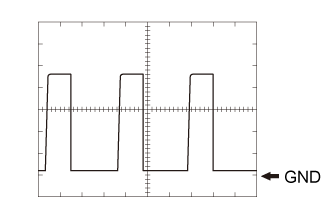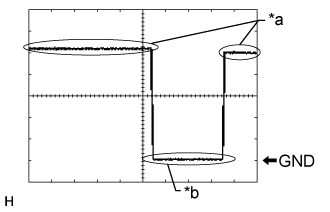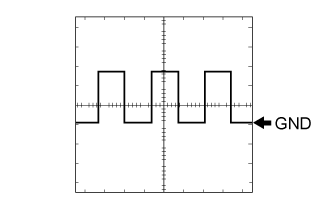Vehicle Interior. Land Cruiser. Urj200, 202 Grj200 Vdj200
Theft Deterrent Keyless Entry. Land Cruiser. Urj200, 202 Grj200 Vdj200
Entry And Start System (For Start Function) -- Terminals Of Ecu |
| CHECK CERTIFICATION ECU (SMART KEY ECU ASSEMBLY) |

Disconnect the E128 and E130 connectors.
Measure the voltage and resistance according to the value(s) in the table below.
- HINT:
- Measure the values on the wire harness side with the connector disconnected.
Tester Connection Input/Output Wiring Color Terminal Description Condition Specified Condition Related Data List Item E128-12 (STA) - Body ground Input R - Body ground When starting the engine, this monitors the voltage sent from terminal STAR to the starter relay to judge whether the engine is "being started". 20°C (68°F) 100 to 111Ω - E128-10 (STAR) - Body ground*1 Input/Output L - Body ground Outputs voltage to the starter relay - Outputs voltage (12 V) to the starter relay when starting the engine. (Max. 30 sec. Turns off when an engine speed of 500 rpm or more continues for 500 ms or more.)
- HINT:
- When Hi is selected, a start request signal (STAR) will not be output even though a start request signal (STSW) is input.
Shift lever in any position other than P or N → shift lever in P or N (at 20°C (68°F)) 10 kΩ or higher → 100 to 111 Ω - Receives neutral start switch (P, N position detection) signal - Monitors whether the neutral start switch is on (P or N) or off (other than P or N). Applies voltage via a resistor (large) in the certification ECU (smart key ECU assembly). When the neutral start switch is on, due to the starter relay coil resistance (small) using some of the voltage, the voltage at terminal STAR will be low (2.7 V or less), and when the neutral start switch is off, the voltage will be high (9 V or more).
Perform the following operations except while the engine is cranking: - Shift lever in any position other than P or N → shift lever in P or N(at 20°C (68°F))
30 kΩ or higher → 100 to 111 Ω Neutral SW/ Clutch SW E128-10 (STAR) - Body ground*2 Input/Output L - Body ground Outputs voltage to the starter relay - Outputs voltage (12 V) to the starter relay when starting the engine. (Max. 30 sec. Turns off when an engine speed of 500 rpm or more continues for 500 ms or more.)
Clutch pedal released → Clutch pedal depressed 10 kΩ or higher → 100 to 111 Ω - Receives clutch start switch signal - Monitors whether the clutch start switch is on (clutch pedal depressed) or off (clutch pedal released). Applies voltage via a resistor (large) in the certification ECU (smart key ECU assembly). When the clutch start switch is on, due to the starter relay coil resistance (small) using some of the voltage, the voltage at terminal STAR will be low (2.7 V or less), and when the clutch start switch is off, the voltage will be high (9 V or more).
Perform the following operations except while the engine is cranking: - Clutch pedal released → Clutch pedal depressed
30 kΩ or higher → 100 to 111 Ω Neutral SW/ Clutch SW E128-14 (NE) - Body ground Input L - Body ground Engine speed signal Always 10 kΩ or higher Engine Condition E128-2 (STP1) - Body ground Input R - Body ground Stop light switch signal Brake pedal released → Brake pedal depressed 9 V or higher → 1 V or less Stop Light Switch1 E130-10 (+B) - E130-11 (E) Input P - BR Power source Always 11 to 14 V - E130-23 (SLP) - E130-11 (E) Input R - BR Steering lock position signal Always 10 kΩ or higher Steering Unlock Switch E130-22 (P) - E130-11 (E)*1 Input LG - BR P position signal Shift lever in P → Shift lever not in P 40 kΩ or higher → 200 Ω or less Shift P Signal E130-11 (E) - Body ground - BR - Body ground GND Always Below 1 Ω - E130-18 (SSW2) - Body ground Input L - Body ground SSW2 contact signal - HINT:
- Backup for SSW1. Behaves the same way as SSW1.
Engine switch pushed → Engine switch not pushed Below 1 Ω → 10 kΩ or higher Start Switch2 E130-16 (SSW1) - Body ground Input GR - Body ground SSW1 contact signal Engine switch pushed → Engine switch not pushed Below 1 Ω → 10 kΩ or higher Start Switch1 E130-9 (ACCD) - Body ground Output B - Body ground ACC signal 20°C (68°F) 95.25 to 107.14 Ω ACC Relay Monitor E128-3 (IG1D) - Body ground Output L - Body ground IG1 signal 20°C (68°F) 38.34 to 55.81 Ω IG1 Relay Monitor(Outside) E128-4 (CUTB) - E130-11 (E) Input V - BR Dark current cut pin*3 Always 11 to 14 V - E130-5 (SPD) - Body ground Input L - Body ground Vehicle speed signal Always 30 kΩ or higher Vehicle Speed Signal - *1: for Automatic Transmission
- *2: for Manual Transmission
- *3: In order to prevent the vehicle battery from being depleted when the vehicle is shipped long distances, a fuse that cuts unnecessary electrical load while the vehicle is being shipped is set in the circuit. If the fuse is removed, the circuit becomes open. If the fuse that is between the vehicle battery and terminal CUTB is removed and the circuit is open, the certification ECU (smart key ECU assembly) changes to a certain control mode (example: the transmission of electric waves every 0.25 seconds. that form the detection area stops).
Reconnect the E128 and E130 connectors.
Measure the voltage and check for pulses according to the value(s) in the table below.
Tester Connection Input/Output Wiring Color Terminal Description Condition Specified Condition Related Data List Item E128-12 (STA) - E130-11 (E) Input R - BR When starting the engine, this monitors the voltage sent from terminal STAR to the starter relay to judge whether the engine is "being started". With the brake pedal depressed, the engine switch is pressed and held (starter on) → After approx. 1 sec. has elapsed, the engine switch is released (starter off) 6 V or higher*3 → 1.5 V or less - E128-10 (STAR) - E130-11 (E)*1 Input/Output L - BR Outputs voltage to the starter relay - Outputs voltage (12 V) to the starter relay when starting the engine. (Max. 30 sec. Turns off when an engine speed of 500 rpm or more continues for 500 ms or more.)
- HINT:
- When Hi is selected, a start request signal (STAR) will not be output even though a start request signal (STSW) is input.
With the brake pedal depressed, the engine switch is pressed and held → After approx. 1 sec. has elapsed, the engine switch is released 6 V or higher*3 → 1.5 V or less - Receives neutral start switch (P, N position detection) signal - Monitors whether the neutral start switch is on (P or N) or off (other than P or N). Applies voltage via a resistor (large) in the certification ECU (smart key ECU assembly). When the neutral start switch is on, due to the starter relay coil resistance (small) using some of the voltage, the voltage at terminal STAR will be low (2.7 V or less), and when the neutral start switch is off, the voltage will be high (9 V or more).
Perform the following operations except while the engine is cranking: - Shift lever in any position other than P or N → shift lever in P or N
9 V or higher → 2.7 V or less Neutral SW/ Clutch SW E128-10 (STAR) - E130-11 (E)*2 Input/Output L - BR Outputs voltage to the starter relay - Outputs voltage (12 V) to the starter relay when starting the engine. (Max. 30 seconds. Turns off when an engine speed of 500 rpm or more continues for 500 ms or more.)
- HINT:
- When Hi is selected, a start request signal (STAR) will not be output even though a start request signal (STSW) is input.
With the clutch pedal depressed, the engine switch is pressed and held → After approximately 1 second has elapsed, the engine switch is released 6 V or higher*3 → 1.5 V or less - Receives clutch start switch signal - Monitors whether the clutch start switch is on (clutch pedal depressed) or off (clutch pedal released). Applies voltage via a resistor (large) in the certification ECU (smart key ECU assembly). When the clutch start switch is on, due to the starter relay coil resistance (small) using some of the voltage, the voltage at terminal STAR will be low (2.7 V or less), and when the clutch start switch is off, the voltage will be high (9 V or more).
Perform the following operations except while the engine is cranking: - Clutch pedal released → Clutch pedal depressed
9 V or higher → 2.7 V or less Neutral SW/ Clutch SW E128-14 (NE) - E130-11 (E) Input L - BR Engine speed signal Idling (engine warmed up) Pulse generation
(See waveform 1)Engine Condition E128-2 (STP1) - E130-11 (E) Input R - BR Stop light switch signal Brake pedal released → Brake pedal depressed 1 V or less → 9 V or higher Stop Light Switch1 E130-23 (SLP) - E130-11 (E) Input R - BR Steering lock position signal Steering wheel locked → Steering wheel unlocked 11 to 14 V → 1.5 V or less Steering Unlock Switch E130-24 (SLR+) - E130-11 (E) Output W - BR Steering lock motor operation command signal
(Steering lock motor operation permission signal sent from the certification ECU (smart key ECU assembly))When a door is opened, the steering lock motor will be operated if all of the following conditions are met:- The steering is unlocked.
- The engine switch is off.
- The shift lever is in P.
Pulse generation
(See waveform 2)- E130-22 (P) - E130-11 (E)*1 Input LG -BR P position signal Shift lever in P → Shift lever not in P 9 V or higher → 2.76 V or less Shift P Signal E130-18 (SSW2) - E130-11 (E) Input L - BR SSW2 contact signal - HINT:
- Backup for SSW1. Behaves the same way as SSW1.
Engine switch not pushed → Engine switch pushed 9 V or higher → 1 V or less Start Switch2 E130-16 (SSW1) - E130-11 (E) Input GR - BR SSW1 contact signal Engine switch not pushed → Engine switch pushed 9 V or higher → 1 V or less Start Switch1 E130-9 (ACCD) - E130-11 (E) Output B - BR ACC signal Engine switch off → Engine switch on (ACC) 1 V or less → 8.5 V or higher ACC Relay Monitor E128-3 (IG1D) - E130-11 (E) Output L - BR IG1 signal Engine switch on (ACC) → Engine switch on (IG) 1 V or less → 9 V or higher IG1 Relay Monitor(Outside) E130-5 (SPD) - E130-11 (E) Input L - BR Vehicle speed signal Vehicle being driven at approx. 5 km/h (3 mph) Pulse generation
(See waveform 3)Vehicle Speed Signal - *1: for Automatic Transmission
- *2: for Manual Transmission
- *3: While the engine is cranking, the battery voltage may drop to approximately 6 V.
- HINT:
- The waveform of the steering lock actuator motor stopped can be checked without performing any particular operation.
- The waveform of the steering lock actuator motor operating can be checked if either of the following operations is performed:
- To unlock the steering, bring the electrical key transmitter sub-assembly into the cabin and turn the engine switch on (ACC) or on (IG).
- To lock the steering, open a door with the engine switch off and the shift lever in P.
- Outputs voltage (12 V) to the starter relay when starting the engine. (Max. 30 sec. Turns off when an engine speed of 500 rpm or more continues for 500 ms or more.)
Using an oscilloscope, check the waveform of the ECU.
- HINT:
- The oscilloscope waveform shown in the illustration is an example for reference only. Noise, chattering, etc. are not shown.
Waveform 1
Item Content Tester Connection E128-14 (NE) - E130-11 (E) Tool Setting 2 V/DIV., 2 ms./DIV. Vehicle Condition Idling (engine warmed up) - HINT:
- The wavelength becomes shorter as the engine speed increases.
Waveform 2
Item Content Tester Connection E130-24 (SLR+) - E130-11 (E) Tool Setting 2 V/DIV., 200 ms./DIV. Vehicle Condition Steering lock motor stopped →
Steering lock motor operating →
Steering lock motor stoppedText in Illustration *a Steering lock motor not operating *b Steering lock motor operating Waveform 3
Item Content Tester Connection E130-5 (SPD) - E130-11 (E) Tool Setting 5 V/DIV., 20 ms./DIV. Vehicle Condition Engine switch on (IG), vehicle being driven at approx. 5 km/h (3 mph) - HINT:
- The wavelength becomes shorter as the vehicle speed increases.



| CHECK STEERING LOCK ECU (STEERING LOCK ACTUATOR ASSEMBLY) (Click here) |
| CHECK ID CODE BOX (IMMOBILISER CODE ECU) (Click here) |